 |
 |
 |
| |
Pharmacokinetics, Safety, and Efficacy of Atazanavir or
Darunavir With Cobicistat in Adolescents (12 to <18 years of age)
|
| |
| |
Reported by Jules Levin
CROI 2017 Feb 14-16 Seattle WA
Elizabeth J. McFarland,1 Gloria Heresi,2 Jagmohan Batra,3 Torsak Bunupuradah,4 Kulkanya Chokephaibulkit,5 Pope Kosalaraksa,6 Pamela Wong,7 Heather Zhang,7 Cheryl Pikora,7 Martin S. Rhee7
1University of Colorado Anschutz Medical Campus, Aurora, CO; 2University of Texas McGovern Medical School, Houston, TX; 3Miller Children’s & Women’s Hospital, Long Beach, CA; 4The HIV Netherlands Australia Thailand Research Collaboration, Bangkok, Thailand;
5Faculty of Medicine Siriraj Hospital, Mahidol University, Bangkok, Thailand; 6Joint Clinical Research Centre, Kampala, Uganda; 7Gilead Sciences, Inc., Foster City, CA
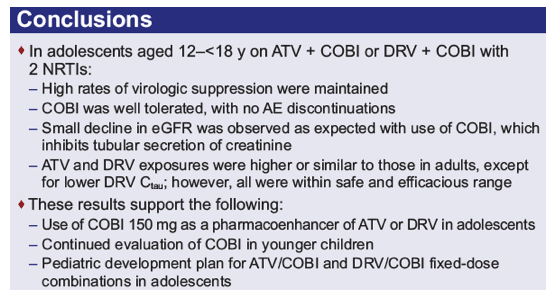
Abstract Body:
Cobicistat (COBI) is a potent, mechanism-based inhibitor of CYP3A, thus, when coadministered, can increase the systemic exposure of CYP3A substrates. It is approved for use as a pharmacoenhancer for atazanavir (ATV) or darunavir (DRV) and for elvitegravir (EVG) within EVG-containing single-tablet regimens (e.g. EVG/COBI/emtricitabine/tenofovir alafenamide).
We conducted a prospective, single-arm, open-label, 2-part, 48-week trial to explore the pharmacokinetics (PK), safety, and efficacy of switching from ritonavir (RTV) to COBI as a boosting agent for ATV or DRV. We enrolled virologically-suppressed adolescent participants (12 to <18 years) on a stable regimen consisting of either RTV-boosted ATV or RTV-boosted DRV plus 2 NRTIs. The adult dosage of COBI 150 mg was administered and plasma exposures of ATV and DRV were evaluated by intensive PK on Day 10. We report data from Part A, in which all participants participated in intensive PK sampling and were followed through Week 12.
We enrolled 22 adolescents; median age 14 years (range 12-17), median body weight 52.7 kg, 36% female, 23% Black, mean CD4 count 989 cells/μL. Participants received COBI with ATV (n=14) or DRV (n=8). In adolescents (vs adult historical intensive PK data), steady-state plasma exposures of ATV and DRV were modestly higher (24-71%) (ATV) or similar (DRV), except DRV Ctau was slightly lower when combined with COBI (Table). Exposures to both protease inhibitors fell within safe and efficacious ranges of adults. No participant experienced treatment-related serious adverse events (AEs) or AEs leading to study drug discontinuation. Small decreases in eGFRSchwartz (median -6.7 mL/min/1.73m2) were seen at Week 12, consistent with the inhibitory effect of renal creatinine secretion by COBI. Most participants, 21 of 22 (95%), had HIV-1 RNA <50 c/mL at Week 12.
In adolescents, when boosted with adult dosage strength of COBI, plasma exposures of ATV and DRV were within safe and efficacious ranges as seen in adults. Virologic suppression was maintained and treatment was generally well tolerated through 12 weeks. These findings support ongoing evaluation of COBI 150 mg as a pharmacoenhancer of ATV or DRV in adolescents 12 to <18 years of age.
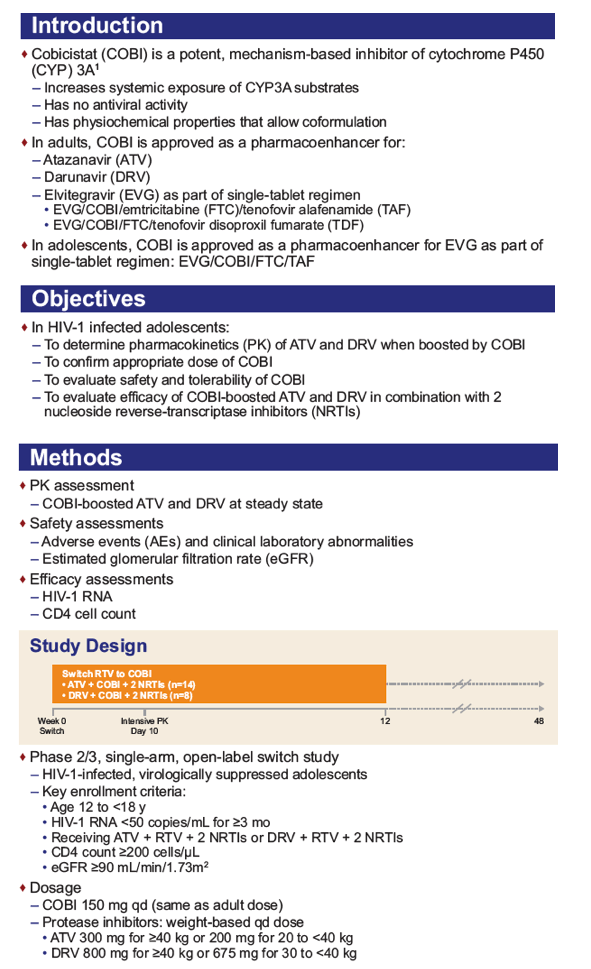
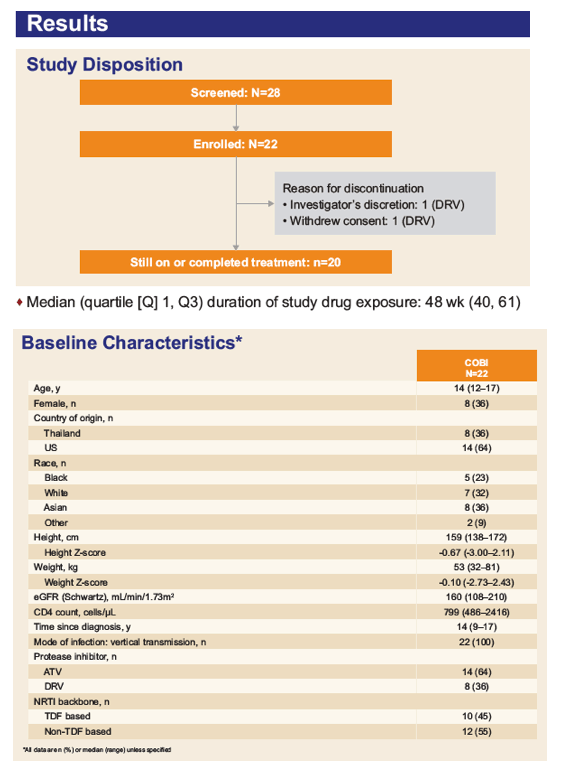
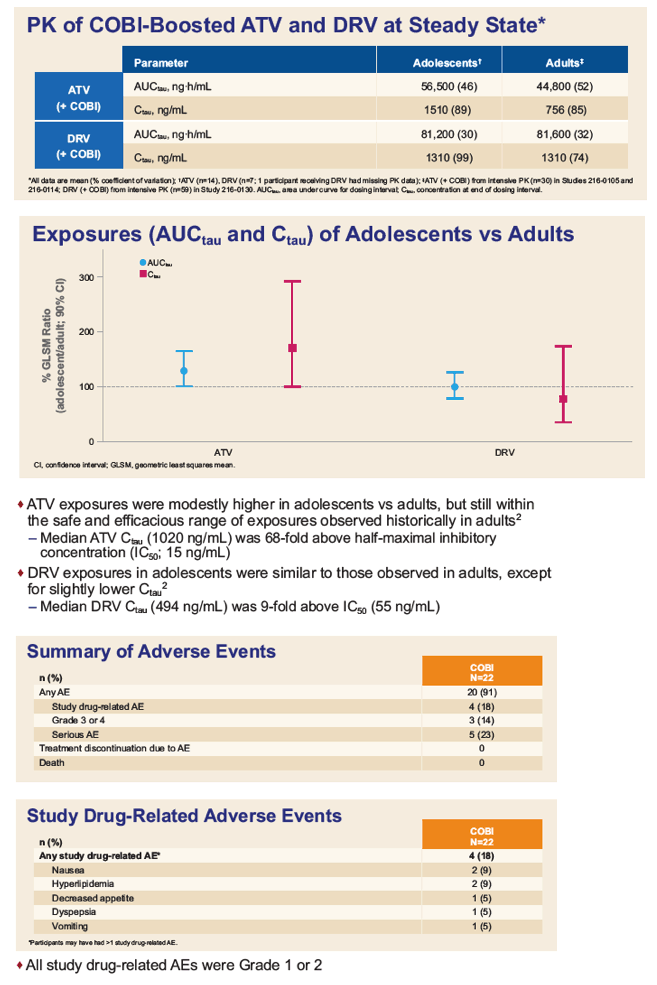
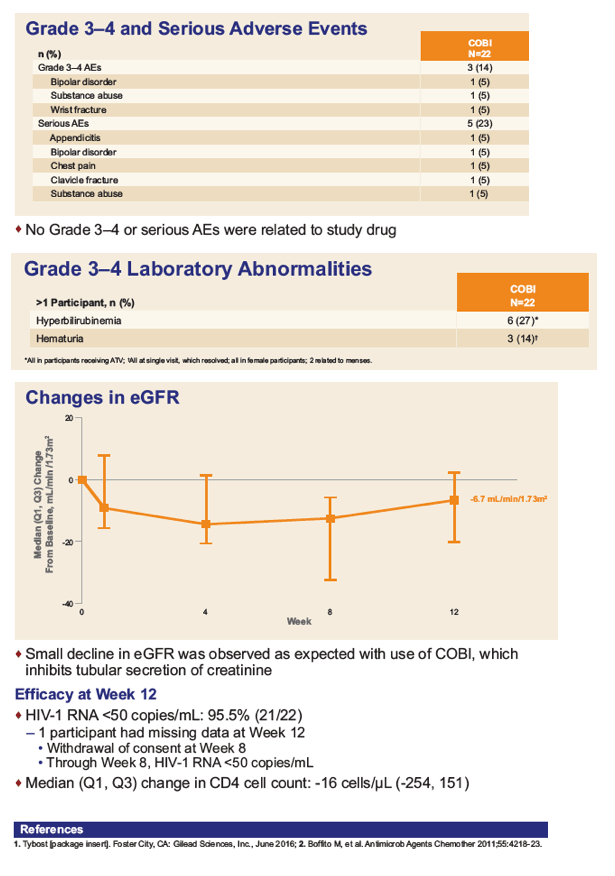
|
| |
|
 |
 |
|
|